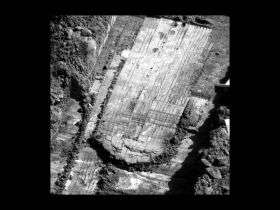Trench on Mars Ready for Next Sampling by NASA Lander

(PhysOrg.com) -- NASA's Phoenix Mars Lander has groomed the bottom of a shallow trench to prepare for collecting a sample to be analyzed from a hard subsurface layer where the soil may contain frozen water.
Images received Thursday morning confirmed that the lander's robotic arm had scraped the top of the hard layer clean during activities of Phoenix's 58th Martian day, or sol, corresponding to overnight Wednesday to Thursday.
The Phoenix team developed commands for sending to the spacecraft Thursday to complete two remaining preparations necessary before collecting a sample and delivering it to the lander's Thermal and Evolved-Gas Analyzer (TEGA). One part of the plan for Sol 59 (overnight Thursday to Friday) would assure that the scoop is empty of any soil collected earlier. Another would complete a final cleaning of any volatile materials from the oven that will receive the sample.
In the past two weeks, the team has refined techniques for using a powered rasp on the back of the arm's scoop to cut and collect shavings of material from the bottom of the trench. The trench, informally named "Snow White," is 4 to 5 centimeters deep (about 2 inches), about 23 centimeters wide (9 inches), and about 60 centimeters long (24 inches) long.
"The rasped material ends up in the back of the scoop, and we have to transfer it to the front through a pathway. That takes a series of arm moves to be sure the material gets through the pathway," said Robert Bonitz of NASA's Jet Propulsion Laboratory, Pasadena, Calif., manager for the robotic arm. "The reason we're doing it today is we want to be sure the pathway is free of any material collected previously before we collect the next sample for delivery to TEGA."
The planned activity would repeat the series of pathway-clearing moves twice, and check visually to be sure the front of the scoop is empty. It is also important to get the background counts as low as possible in TEGA's evolved-gas analyzer, which receives vapors emitted from the oven. The instrument was heated repeatedly before launch and during the flight to Mars to drive off any volatile material in it, such as water and carbon-dioxide gases that tend to stick on surfaces. It got another heating on Sol 58.
"The baking last night was to remove background volatiles stuck on the walls of the instrument," said William Boynton of the University of Arizona, Tucson, lead scientist for TEGA. "What we're planning today is pumping out any gas we might have released with the baking."
Other activities in the plan for the sol beginning today include weather monitoring and photography of several areas. Some planned use of the Surface Stereo Imager would record the same view consecutively through 15 different filters. Each filter lets through only a limited band of wavelengths of visible or infrared light. Using just red, green and blue filters allows the team to make full-color images. Using the additional filters provides more information useful for interpreting geological or atmospheric qualities of the image target.
Provided by NASA





















